PC Software: Windows 7 Ultimate Build 7600
File Type: FLAC Compression 6
Cd Hardware: Plextor PX-716SA
Plextor Firmware: 1.11 (Final)
Cd Software: Exact Audio Copy V0.99 prebeta 5
EAC Log: Yes (for my rips)
EAC Cue Sheet: Yes (for my rips)
Tracker(s): http://fr33dom.h33t.com:3310/announce; http://tracker.openbittorrent.com/announce; http://inferno.demonoid.com:3391/announce
Torrent Hash: 76EA1CE2B5AFA59AC9A365AAC60461D622B8D471
File Size: 6.97 GB
Labels: Atlantic, Atco, Arista, Victory Records, Sanctuary, Eagle
Albums, Years & Catalog # in this Torrent:
Yes 1969 (Remastered)
Time and a Word 1970 (Remastered)
The Yes Album 1971 (Remastered)
Fragile 1971
Close to the Edge 1972 (Remastered)
Tales from Topographic Oceans 1973
Going for the One 1977
Relayer 1974 (Remastered)
Going for the One 1977
Tormato 1978 (Remastered)
Drama 1980
90125 1983 CD 90125 *
Big Generator 1987 CD 90522 *
Union 1991 ARCD-8643 *
Talk 1994 422 828 489-2 *
Open Your Eyes 1997 BYCD3074 *
The Ladder 1999
Magnification 2001 (Reissued 2004)
* Denotes My Rip
I need to thank some fellow uploaders, especially Troma for his fine Yes releases. These include Yes, Time and a Word, The Yes Album, Fragile and my request for The Ladder. Thanks bro! Also to Pirate Bay member downup for Magnification, Going for the One, Relayer and Tales from Topographic Oceans. Also to a couple of others that helped complete this discography. Thanks to all! I left out Keys to Ascension 1 & 2 as they are for the most part live albums although Wiki has them down as part of the studio discography (because of a couple of new released tracks). I also left out Anderson, Bruford, Wakeman Howe. I did this to keep the file size more manageable for as its 7 GB, these 3 albums would have pushed it to 9 GB.
Please help seed these FLACs!
From Wiki:
Quote:
Yes are an English progressive rock band formed in London in 1968, generally regarded as one of the archetypal bands and pioneers of the genre. Despite many lineup changes, occasional splits within the group and the ever-changing trends in popular music, the band has continued for over forty years and still retains a large following.[1]
The band's music blends symphonic and other "classical" structures with their own brand of rock music, which is marked by sharp dynamic contrasts, long songs, abstract lyrics, and an integrated showcasing of instrumental prowess. Although the band's sole consistent member has been bass player Chris Squire (noted for his highly melodic and discursive playing as well as his early use of electronic effects), Yes are also generally noted for the distinctive high-register vocals of lead singer Jon Anderson and the eclectic musical stylings of a succession of guitarists (Peter Banks, Steve Howe, Trevor Rabin, Billy Sherwood), keyboard players (Tony Kaye, Rick Wakeman, Patrick Moraz, Geoff Downes, Igor Khoroshev) and drummers (Bill Bruford and Alan White). Several band members became celebrated musicians and/or bandleaders in their own right, and a 1980 lineup of the band was briefly fronted by future production star Trevor Horn. They have sold over 30 million records in over 40 years of activity.
Long-term band members Squire, Howe and White are currently touring with a Yes lineup featuring vocalist Benoît David and keyboardist Oliver Wakeman.
Yes 1969
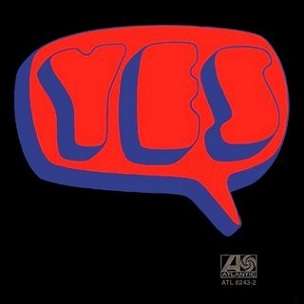
Yes is the 1969 debut album from British progressive rock band Yes, considered among the first progressive rock albums. With the original Yes line-up of vocalist Jon Anderson, bassist Chris Squire, guitarist Peter Banks, keyboardist Tony Kaye and drummer Bill Bruford, Yes was the quintet's original musical release.
While many music critics regarded it as a strong initial effort, the album was not a large commercial success, due in part to the inexperience of the band and the producers. The album was also overshadowed by Led Zeppelin's debut album, released earlier that year.
Two of the eight songs on the album are covers, which the band use to demonstrate their penchant for massively reworking others' songs; The Beatles' "Every Little Thing" is turned into a grungy wall of sound with several tempo and key changes with an extended jam opening, and The Byrds' "I See You" becomes a jazzy psychedelic workout for Banks and Bruford to display their instrumental virtuosity.
Lester Bangs favourably reviewed the album in Rolling Stone, writing that it was "the kind of album that sometimes insinuates itself into your routine with a totally unexpected thrust of musical power."
Tracks:
1. "Beyond and Before" (Squire/Clive Bailey) – 4:58
2. "I See You" (Jim McGuinn/David Crosby; Essex Music Ltd.) – 6:54
3. "Yesterday and Today" (Anderson) – 2:53
4. "Looking Around" (Anderson/Squire) – 4:05
5. "Harold Land" (Anderson/Bruford/Squire) – 5:45
6. "Every Little Thing" (Lennon/McCartney; Northern Songs) – 5:46
7. "Sweetness" (Anderson/Clive Bailey/Squire) – 4:35
8. "Survival" (Anderson) – 6:23
9. "Everydays (Single Version)" (Stephen Stills) – 6:23
10. "Dear Father (Early Version #2)" (Anderson/Squire) – 5:51
11. "Something's Coming" (Leonard Bernstein/Stephen Sondheim) – 7:09
12. "Everydays (Early Version)" (Stephen Stills) – 5:18
13. "Dear Father (Early Version #1)" (Anderson/Squire) – 5:31
14. "Something's Coming (Early Version)" (Leonard Bernstein/Stephen Sondheim) – 8:02
Time and a Word 1970
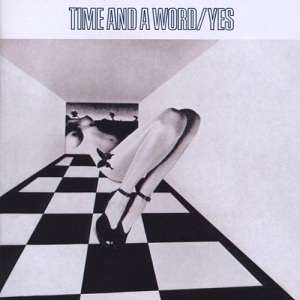
Time and a Word is the second album by progressive rock band Yes, released in mid-1970 in the UK and November 1970 in the US. This was the last Yes album to feature the group's original line-up, as Peter Banks was fired before the album's release.
Time and a Word (Atlantic 2400 006) reached #45 in the UK. It did not chart in the US.
Tracks:
1. "No Opportunity Necessary, No Experience Needed" (Richie Havens) – 4:48
2. "Then" (Anderson)* – 5:46
3. "Everydays" (Stephen Stills) – 6:08
4. "Sweet Dreams" (Anderson, David Foster) – 3:50
5. "The Prophet" (Anderson, Squire) – 6:34
6. "Clear Days" (Anderson) – 2:06
7. "Astral Traveller" (Anderson) – 5:53
8. "Time and a Word" (Anderson, David Foster) – 4:32
9. "Dear Father" (Anderson, Squire) – 4:14
10. "No Opportunity Necessary, No Experience Needed (Original Mix)" (Havens) – 4:46
11. "Sweet Dreams (Original Mix)" (Anderson, Foster) – 4:20
12. "The Prophet (Single Version)" (Anderson, Squire) – 6:33
The Yes Album 1971
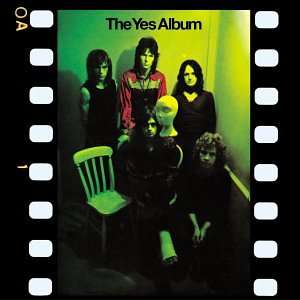
The Yes Album is the third album by British progressive rock band Yes. The first release to feature 23-year-old guitarist Steve Howe, the album was released on Atlantic Records in February 1971 in the UK, a month later in the United States. This was the album that finally set Yes' career alight, with the album reaching #4 in the UK and, eventually, #40 in the U.S., where it was a platinum seller. This was also the last Yes album for more than twelve years to feature keyboardist Tony Kaye until his return in 1983's 90125.
The Yes Album set the stage for the band's route to superstardom with Fragile and Close to the Edge. This was their first commercial success.
The album was recorded at an old farmhouse in Devon, England, which was then home to Langley Studios. Howe loved the place so much, that he later bought the building and surrounding land and now lives there.
Jon Anderson is credited as John Anderson on the album. Shortly afterwards he dropped the "h" from his first name.
The album cover shows Tony Kaye with his foot in a cast. He had been in a car accident shortly before the picture was taken.
Tracks:
1. "Yours Is No Disgrace" (Jon Anderson/Chris Squire/Steve Howe/Tony Kaye/Bill Bruford) – 9:41
2. "Clap" (Howe) – 3:17
o Recorded live at The Lyceum Theatre, London, 17 July 1970
3. "Starship Trooper" – 9:25
1. "Life Seeker" (Anderson)
2. "Disillusion" (Squire)
3. "Würm" (Howe)
4. "I've Seen All Good People" – 6:56
0. "Your Move" (Jon Anderson)
1. "All Good People" (Chris Squire)
5. "A Venture" (Jon Anderson) – 3:18
6. "Perpetual Change" (Jon Anderson/Chris Squire) – 8:54
7. "Your Move" (Single Version) - 3:00
8. "Life Seeker" (Single Version) - 3:28
9. "Clap" (Studio Version) - 4:02
Fragile 1971

Fragile is the fourth album by the British progressive rock band Yes, released on Atlantic Records, catalogue 7211. It was the band's first album with keyboardist Rick Wakeman after the departure of Tony Kaye, and the first to feature cover art by Roger Dean, his work emblematic of both the band and progressive rock as a whole. Fragile was issued in the UK in November 1971, but was held back in North America for two months because of the chart momentum of The Yes Album. It peaked at #4 on the Billboard 200 during a stay of 46 weeks, and as Atlantic 2401 019 reached #7 in the UK album chart.
Tracks:
1. "Roundabout" (Anderson/Howe) – 8:30
2. "Cans and Brahms (Extracts from Brahms' 4th Symphony in E Minor, Third Movement)" (Brahms, arranged Wakeman) – 1:38
3. "We Have Heaven" (Anderson) – 1:40
4. "South Side of the Sky" (Anderson/Squire) – 8:02
5. "Five Per Cent for Nothing" (Bruford) – 0:35
6. "Long Distance Runaround" (Anderson) – 3:30
7. "The Fish (Schindleria Praematurus)" (Squire) – 2:39
8. "Mood for a Day" (Howe) – 3:00
9. "Heart of the Sunrise" (Anderson/Squire/Bruford) – 11:27
Close to The Edge 1972

Close to the Edge is the fifth album by the British progressive rock band Yes.
According to the vocalist, Jon Anderson, the title track is inspired by Hermann Hesse's book Siddhartha. This interpretation, which can cast the cryptic and mysterious lyrics in a new light, reads the song as tracking the awakening of Hesse's character "close to the edge" of a river (and, symbolically, of the serial lifetimes of his soul), where he experiences a spiritual awakening.
The spiritual influences introduced by Jon Anderson, which later formed the basis of Tales from Topographic Oceans, are already evident in the music and lyrics of all three tracks on Close to the Edge. Renewal and repetition are other main themes; the title track starts and finishes with the same sound effects of running water and birds, and in "Siberian Khatru" there is the repetition of two-syllable words and phrases. This will come up many times later in songs like "The Revealing Science of God", "Going for the One", "To Be Over", and "Rhythm of Love".
In June 1972, just as recording ended, drummer Bill Bruford suddenly left the line-up to play with King Crimson, forcing Yes to find a replacement drummer (ex-Plastic Ono Band member Alan White) before starting a new U.S. tour.
This album set a trend for Yes of structuring an album around a single epic song, significantly longer than the album's other tracks. Here the centerpiece is the song "Close to the Edge". Later Yes albums that follow a similar pattern are Relayer (which features "The Gates of Delirium"), Going for the One (which features "Awaken") and Talk (which features "Endless Dream").
Tracks:
1. "Close to the Edge"
• "The Solid Time of Change"
• "Total Mass Retain"
• "I Get Up I Get Down"
• "Seasons of Man"
2. "And You and I"
• "Cord of Life"
• "Eclipse"
• "The Preacher the Teacher"
• "Apocalypse"
3. "Siberian Khatru"
4. "America" (single version)
5. "Total Mass Retain" (single version)
6. "And You and I" (alternate version)
7. "Siberia" (studio run-through of "Siberian Khatru")
Tales from Topographic Oceans 1973
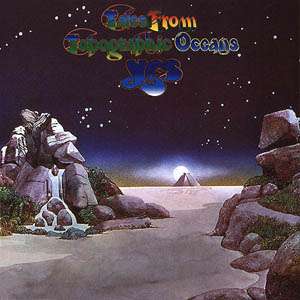
Tales from Topographic Oceans is the sixth studio album by British progressive rock band Yes. It is a double album, released on Atlantic Records in December 1973 in most of the world and in January 1974 in North America.
According to the documentary Classic Artists: Yes, Jon Anderson was originally going to call the album Tales From Turbographic Oceans. He mentioned the title while having dinner with Atlantic CEO Phil Carson, who noted that "turbographic" sounded like "topographic". Anderson liked the word and changed the album title accordingly.
Tales from Topographic Oceans was recorded in studio 3 of Morgan Studios at the same time heavy metal band Black Sabbath was recording their fifth album, Sabbath Bloody Sabbath, in studio 4. According to Sabbath lead singer Ozzy Osbourne's 2010 autobiography I Am Ozzy the band decorated their recording studio with model cows–complete with electronic udders–bales of hay, and a small barn, to give the room an "earthy" feel.[1]
The album's concept, a two-disc, four-piece work of symphonic length and scope (based on the Shastric scriptures, as found in a footnote within Paramahansa Yogananda's book Autobiography of a Yogi), was their most ambitious to date. The four songs of the album symbolise (in track order) the concepts of Truth, Knowledge, Culture, and Freedom, the subjects of that section of text. According to drummer Bill Bruford in his autobiography (p. 72), former King Crimson percussionist Jamie Muir introduced vocalist Jon Anderson to Paramahansa Yogananda's work during Bruford's wedding in March 1973, and therefore had an indirect impact on the album's concept.
Tracks:
1. "The Revealing Science of God (Dance of the Dawn)"
2. "The Remembering (High the Memory)"
3. "The Ancient (Giants under the Sun)"
4. "Ritual (Nous sommes du soleil)"
Relayer 1974
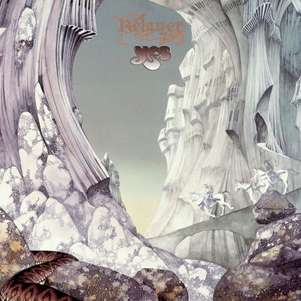
Relayer is the seventh studio album by the progressive rock band Yes. Recorded and released in 1974, it is the only Yes studio album to feature Patrick Moraz, who replaced keyboardist Rick Wakeman earlier in the year. Relayer reached #4 in the UK (remaining 8 weeks in the top-40) and #5 in the US (remaining 16 weeks in the top-200).
Tracks:
1. "The Gates of Delirium"
2. "Sound Chaser"
3. "To Be Over"
4. "Soon" (Single version)
5. "Sound Chaser" (Single version)
6. "The Gates of Delirium" (Studio run-through)
Going for the One 1977
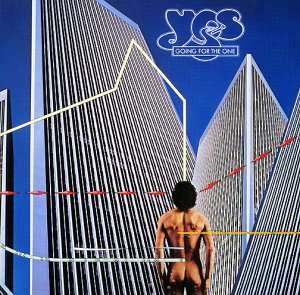
Going for the One is the eighth studio album by British progressive rock band Yes. It was released in 1977 after an extended break for solo activity, and is especially notable for marking the return of keyboardist Rick Wakeman, who had departed in 1974 in the aftermath of the Tales from Topographic Oceans tour. His re-entry was facilitated by the departure of Patrick Moraz, after having only played on Relayer, although Moraz is thanked in the credits.
With its confident and natural qualities, Going for the One is still generally regarded by most critics as one of Yes's finest, and many times, most underrated albums[citation needed]. Allmusic's Ross Boissoneau has decribed this album as "perhaps the most overlooked item in the Yes catalog".0 Jon Anderson has said of the song "Awaken". "We had a hit record! I loved listening to 'Awaken', at last we had created a Masterwork" 1 and has indicated in some interviews that he considers it to be Yes's most complete composition.
Tracks:
1. "Going for the One" (Jon Anderson) – 5:32
2. "Turn of the Century" (Jon Anderson/Steve Howe/Alan White) – 7:56
3. "Parallels" (Chris Squire) – 5:53
4. "Wonderous Stories" (Jon Anderson) – 3:49
5. "Awaken" (Jon Anderson/Steve Howe) – 15:31
Tormato 1978
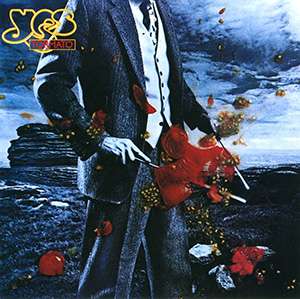
Tormato is the ninth studio album by British progressive rock group Yes. Issued as the follow-up to 1977's acclaimed Going for the One, Tormato received less than charitable reviews upon release[1] and its virtues are still a matter of debate for Yes fans and critics, although some point out that, while the compositions became shorter and more catchy, the classic Yes sound was still alive and well. However, many fans and some band members - particularly Rick Wakeman - state that the production was faulty, resulting in compressed and dull sound,[2] and Squire's bass lacked most of his earlier power.
Tracks:
1. "Future Times" (Jon Anderson/Chris Squire/Steve Howe/Rick Wakeman/Alan White)/ "Rejoice" (Jon Anderson) – 6:46
2. "Don't Kill the Whale" (Jon Anderson/Chris Squire) – 3:56
3. "Madrigal" (Jon Anderson/Rick Wakeman) – 2:25
o String arrangement by Andrew Pryce Jackman from an original idea by Rick Wakeman
4. "Release, Release" (Jon Anderson/Alan White/Chris Squire) – 5:44
5. "Arriving UFO" (Jon Anderson/Steve Howe/Rick Wakeman) – 6:07
6. "Circus of Heaven" (Jon Anderson) – 4:31
o Featuring the voice of Jon Anderson's son, Damion
7. "Onward" (Chris Squire) – 4:05
o Arrangement and orchestration by Andrew Pryce Jackman
8. "On the Silent Wings of Freedom" (Jon Anderson/Chris Squire) – 7:47
9. "Abilene" (Steve Howe) – 4:02
o B-side to "Don't Kill the Whale
10. "Money" (Chris Squire/Jon Anderson/Alan White/Rick Wakeman) – 3:15
o Previously released on Yesyears. It features a satirical voice-over by Wakeman pretending to be Denis Healey, Labour Chancellor of the Exchequer 1974-9 and disliked by more than one successful rock musician for his policies of high taxation rates for the wealthy
11. "Picasso" (Jon Anderson) – 2:12
o About the artist Pablo Picasso
o Re-worked for Jon Anderson's yet to be released musical Chagall.
12. "Some Are Born" (Jon Anderson) – 5:42
o Re-worked by Anderson for his solo album Song of Seven'
13. "You Can Be Saved" (Chris Squire) – 4:20
14. "High" (Steve Howe) – 4:30
o Re-worked by Howe as the instrumental "Sketches in the Sun", later released on GTR
15. "Days" (Jon Anderson) – 1:00
o An a cappella recording; re-worked by Anderson for his solo album Song of Seven'
16. "Countryside" (Jon Anderson/Steve Howe/Chris Squire/Alan White) – 3:11
o Re-worked by Howe as "Corkscrew" for the album Turbulence
17. "Everybody's Song" (Jon Anderson/Steve Howe/Chris Squire/Alan White) – 6:48
o An early version of what became "Does It Really Happen?" on Drama. A solo on the piece sounds more like the work of Patrick Moraz than Wakeman, dating the song to sessions from before Going for the One; in a 2006 interview for Notes From The Edge, Moraz agreed that it probably was him
18. "Onward (Orchestral version)" (Chris Squire) – 3:06
Drama 1980

Drama is the tenth studio album by British progressive rock group Yes. It is unique for being the only Yes album release without vocalist Jon Anderson. In early 1980, after rehearsing music for the follow-up to the tepidly-received Tormato, both Anderson and Rick Wakeman departed the band over creative and financial differences.
Reportedly Anderson and Wakeman were the most enthusiastic about creating a new album, and the rest of the band was lukewarm over the idea, given the relative failure of the last album.[citation needed] This in turn discouraged both Anderson and Wakeman, with the latter at times refusing to leave his room, and both men dejectedly spending time at a local bar. They quit the band soon afterwards.
Undeterred, the remaining members, Chris Squire, Steve Howe and Alan White, carried on. Trevor Horn and Geoff Downes of The Buggles (who had recently had a number one hit in the UK with "Video Killed the Radio Star") were working in an adjacent studio, and being Yes fans, introduced themselves. The pair were invited to sit in during rehearsals, and were soon asked to join the band.
Recorded that spring and released in August, Drama featured a much harder-edged Yes with a distinct new wave flavour (in no small part due to the two new recruits). Perhaps to ensure that some of the old glory was there, Roger Dean was commissioned to design his first Yes cover in five years, and Eddie Offord, who had co-produced the band in their 1971-1974 heyday, returned to the studio for assistance. Drama fared very well in the UK charts, reaching #2 there, but American audiences were not so sure, with Drama becoming Yes's first album there in years to not reach the Top 10 or go gold. However, the supporting tour in the US was another big success. It met with criticism on its UK leg, with some fans angry over Anderson's replacement and Horn's voice suffering from his first experience of major touring, as well as his efforts to match Anderson's higher register.
Horn subsequently quit the band, the others deciding to end the group and begin new projects. Yes officially ended in early 1981, only to reform two years on. Howe and Downes would be in Asia by then.
Yes did not perform any of the songs from Drama live after the 1980 tour until 2008, due to Jon Anderson's refusal to sing them. In 2008 Yes got back together without Anderson and new vocalist Benoît David sang "Machine Messiah" and "Tempus Fugit" with them. They also performed the instrumental beginning to "Tempus Fugit" on the 90125 tour. It has been rumoured that Anderson was prepared to rehearse certain songs from the album in preparation for their 35th Anniversary Tour, but it was the rest of the band that were not prepared, under the assumption that Anderson was still uninterested.
Tracks:
1. "Machine Messiah" – 10:27
2. "White Car" – 1:21
3. "Does It Really Happen?" – 6:35
4. "Into the Lens" – 8:33
5. "Run Through the Light" – 4:43
6. "Tempus Fugit" – 5:15
90125 1983

90125 is the eleventh album by progressive rock group Yes, released in 1983. It was the first album since the breakup of Yes in 1980. It is also the first album to feature Trevor Rabin, and features the return of vocalist Jon Anderson, who quit the band in 1979. It also marked the first time in twelve years that original keyboardist Tony Kaye had appeared with the group. The album is notable for marking a radical shift in style, with Yes largely trading in their trademark symphonic progressive rock sound for contemporary, synthesized 1980s pop.
The title of the album refers to its original catalog number (UK: 7-90125-1, US: 90125-1, German: 79-0125-1), not an American ZIP code (which is not in use).
Tracks:
1. "Owner of a Lonely Heart" (Anderson/Horn/Rabin/Squire) – 4:29
2. "Hold On" (Anderson/Rabin/Squire) – 5:16
3. "It Can Happen" (Anderson/Rabin/Squire) – 5:29
4. "Changes" (Anderson/Rabin/White) – 6:20
5. "Cinema" (Kaye/Rabin/Squire/White) – 2:08
6. "Leave It" (Horn/Rabin/Squire) – 4:14
7. "Our Song" (Anderson/Kaye/Rabin/Squire/White) – 4:18
8. "City of Love" (Anderson/Rabin) – 4:51
9. "Hearts" (Anderson/Kaye/Rabin/Squire/White) – 7:39
Big Generator 1987

Big Generator is the twelfth studio album by progressive rock band Yes. It was released in 1987 on Atlantic Records' Atco subsidiary label (Yes' last studio album for Atlantic) and was the follow-up to the massively successful 90125 album.
A laborious album to make, Big Generator's sessions dragged on for two years, largely due to creative differences. Guitarist Trevor Rabin was aiming to progress beyond 90125, while founding lead vocalist Jon Anderson was beginning to yearn for more traditional Yes music.
The result was an album that was successful commercially, with two songs reaching the US Top 40: "Love Will Find A Way" (also a #1 on the Mainstream Rock chart) and "Rhythm Of Love" (their last US Top 40 hit). The album was not as popular as 90125, and feeling that the band was going in a direction he didn't want to pursue, Jon Anderson began working on other projects at the conclusion of the Big Generator tour in 1988 including a partial reformation with his Yes bandmates from the 1970s.
It is unclear if the album will ever be reissued by Rhino Records with additional bonus tracks as all previous Atlantic studio releases have been. While new additional material has not been available, unreleased demos may be pulled from the Warner vaults, or live material from 1988 used on the box set, Yesyears.
Missing from the Yes "expanded and remastered" 2003/2004 series by Rhino/Warner, (like Yessongs, Yesshows and 9012Live), Big Generator was finally remastered (with inverted stereo image) and expanded in 2009 By Isao Kikuchi, the albums was published by Warner Music Japan as part of their "Yes SHM-CD Papersleeve" series.
Tracks:
1. "Rhythm of Love" (Jon Anderson/Tony Kaye/Trevor Rabin/Chris Squire) – 4:47
2. "Big Generator" (Jon Anderson/Tony Kaye/Trevor Rabin/Chris Squire/Alan White) – 4:33
3. "Shoot High, Aim Low" (Jon Anderson/Tony Kaye/Trevor Rabin/Chris Squire/Alan White) – 7:01
4. "Almost Like Love" (Jon Anderson/Tony Kaye/Trevor Rabin/Chris Squire) – 4:58
5. "Love Will Find a Way" (Trevor Rabin) – 4:50
6. "Final Eyes" (Jon Anderson/Tony Kaye/Trevor Rabin/Chris Squire) – 6:25
7. "I'm Running" (Jon Anderson/Tony Kaye/Trevor Rabin/Chris Squire/Alan White) – 7:37
8. "Holy Lamb (Song for Harmonic Convergence)" (Jon Anderson) – 3:19
Union 1991
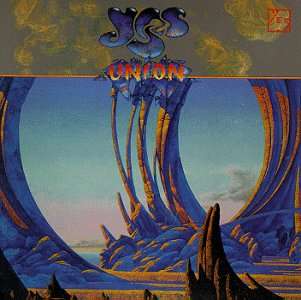
Union is the thirteenth studio album by British progressive rock band Yes, released in 1991. It was intended as a union of Yes (Chris Squire, Trevor Rabin, Alan White, Tony Kaye) and ABWH (Jon Anderson, Bill Bruford, Rick Wakeman, and Steve Howe).
After Big Generator in 1987, Jon Anderson teamed up with ex-Yes men Steve Howe, Rick Wakeman and Bill Bruford. The result was Anderson Bruford Wakeman Howe, released in 1989 and supported by a successful tour. Because of the existence of Yes ( of which Anderson still owned part of the name), this alternate incarnation were forced to use their surnames as the band's name (after Chris Squire threatened legal action). Meanwhile, Yes began composing and recording material for their follow-up, while Anderson Bruford Wakeman Howe did the same, beginning production at Miraval Studios in the South of France in April 1990.
Bowing to record company pressure to resurrect the Yes banner, Squire and Anderson came up with the idea of merging both projects, which resulted in the 1991 album Union. In the meantime the ABWH material had been extensively reworked under the supervision of producer Jonathan Elias, which involved replacing many of Howe's guitar parts with new ones played by sessioner Jimmy Haun. Similarly, with Wakeman unavailable because of his heavy touring schedule as a solo artist, many of the keyboard parts were redone by a variety of players in a variety of studios in Los Angeles and New York.[1]. Post-production also involved Chris Squire adding backing vocals to a couple of ABWH tracks, but this would remain the extent of the "reunion" of the 1971-72 line-up as bass parts on the tracks were performed by Tony Levin.
Tracks:
1. "I Would Have Waited Forever"
2. "Shock to the System"
3. "Masquerade"
4. "Lift Me Up"
5. "Without Hope You Cannot Start the Day"
6. "Saving My Heart"
7. "Miracle of Life"
8. "Silent Talking"
9. "The More We Live/Let Go"
10. "Angkor Wat"
11. "Dangerous (Look in the Light of What You're Searching for)"
12. "Holding On"
13. "Evensong"
14. "Take the Water to the Mountain"
Talk 1994

Talk is the fourteenth studio album by progressive rock band Yes and was released in 1994. Their first release with an independent label after having been distributed the length of their career thus far with Atlantic Records and Arista Records, Talk is also notable for being the last Yes recording with Trevor Rabin and Tony Kaye.
Following the mammoth tour for Union in 1991, the eight-member mega-Yes line-up proved too unwieldy to contain, with Bill Bruford, Steve Howe and Rick Wakeman leaving the band shortly thereafter. Wakeman was originally going to be part of the lineup, but conflicts with management kept this from happening. Remaining was the 1983-88 line-up of Jon Anderson, Chris Squire, Trevor Rabin, Tony Kaye and Alan White.
With Rabin taking the lead - even producing the project himself, he attempted to re-introduce Yes to the 1990s with a lean, guitar-oriented sound. In taking such a strong role, he ensured he had a hand in writing every song, even overdubbing some of Chris Squire's bass parts (to Squire's minor annoyance).
For the first time since 1970s "Time and a Word", the album featured a song co-written by someone outside of the band. Roger Hodgson, formerly of fellow progressive rock band Supertramp, wrote "Walls" with Anderson and Rabin. A demo of this song was recorded in 1990 and included on the Trevor Rabin demo album 90124.
In a 1993 interview, White mentioned a song called "Scarlet From The Tide". It is unknown whether this song became part of a track on the album or if it wasn't added at all.
Pop artist Peter Max created the artwork for Talk. In a 1993 interview, Alan White joked that the album would be called Crunching Numbers. Another working title was History of the Future.
After the album's release, guitarist Billy Sherwood toured with the band. Trevor Rabin and Tony Kaye left the band in 1995, twelve years after teaming up with Jon Anderson, Chris Squire and Alan White. Sherwood would become an official member of Yes in 1997 after Rick Wakeman had re-joined and departed the band in the interim.
Tracks:
1. "The Calling" (Jon Anderson/Trevor Rabin/Chris Squire) – 6:56
2. "I Am Waiting" – 7:25
3. "Real Love" (Trevor Rabin/Chris Squire/Jon Anderson) – 8:49
4. "State of Play" – 5:00
5. "Walls" (Jon Anderson/Trevor Rabin/Roger Hodgson) – 4:57
6. "Where Will You Be" – 6:09
7. " Endless Dream: a. Silent Spring (instrumental)" - 1:55
8. " Endless Dream: b. Talk" - 11:55
9. " Endless Dream: c. Endless Dream" - 1:53
Open Your Eyes 1997
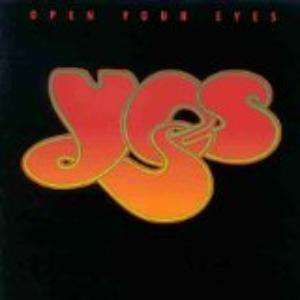
Open Your Eyes is the fifteenth album by progressive rock band Yes and was released in 1997. The follow-up to the twin projects Keys to Ascension and Keys to Ascension 2, Open Your Eyes marked Billy Sherwood becoming an official member of Yes, following Rick Wakeman's departure.
Sherwood had previously been involved with Yes as a backup keyboard player and guitarist on the Talk tour, as a potential new lead singer during Yes rehearsals circa 1990 and as engineer and producer for part of the band's Keys To Ascension project. During this period he had formed a strong working relationship with Yes bassist Chris Squire. Open Your Eyes initially began as an outside collaboration between Sherwood and Squire' with its material intended for the two men's duo project The Chris Squire Experiment (later to become Conspiracy).
Yes singer Jon Anderson was impressed by some of the early Conspiracy material and became interested in singing on it, in part due to the parent band's need for new material to sustain commercial momentum. Consequently Sherwood, Squire, Anderson and White began working on the songs together with the aim of transforming them into Yes songs. Guitarist Steve Howe (at the time, the band's only UK-based member) was not practically involved for most of the process and made his contributions to the album at the end of the sessions (and mainly as a player). By the end of the sessions, Sherwood was formally inducted into Yes - he would play second guitar and sing harmony vocals on tour.
Although Sherwood played the bulk of the keyboards on the album, two other keyboard players were brought in to perform the more complex parts. Steve Porcaro played keyboards on the title track and Russian keyboard player Igor Khoroshev performed on "New State of Mind", "No Way We Can Lose" and "Fortune Seller". Khoroshev was hired as the band's keyboard player on the tour promoting Open Your Eyes (on which he also played percussion and sang backing vocals) and would be a full member by 1999's The Ladder (on which he featured far more prominently).
Open Your Eyes was received with mixed reaction from both critics and fans upon its November 1997 release, some finding it lacking in trademark Yes qualities, while some still praise the album for its upbeat nature. The album was a commercial flop, only reaching #151 in the US while missing the UK charts completely. Several band members later revealed their discontent with the finished album, with both Anderson and Howe claiming that the album was too rushed to incorporate their ideas and suffered as a result.[citation needed] (The sole Anderson/Howe contribution, in terms of writing and concept, was the song "From The Balcony".)
The album is notable in the Yes catalogue for cross-referencing other recordings related to the band. Versions of "Open Your Eyes" and "Man In The Moon" later appeared on the eponymous Conspiracy album (which was delayed for two years due to material being co-opted for Yes and Sherwood's entry into the band). The song "Somehow, Someday" incorporates the first verse melody and lyrics from the song "Boundaries" on Jon Anderson's 1982 solo album Animation. The cover of Open Your Eyes also references the band's 1969 album debut.
Tracks:
1. "New State of Mind" – 6:00
2. "Open Your Eyes" – 5:14
3. "Universal Garden" – 6:17
4. "No Way We Can Lose" – 4:56
5. "Fortune Seller" – 5:00
6. "Man in the Moon" – 4:41
7. "Wonderlove" – 6:06
8. "From the Balcony" – 2:43
9. "Love Shine" – 4:38
10. "Somehow, Someday" – 4:47
11. "The Solution" – 5:26
12. "The Source" – 16:21 (hidden track)
The Ladder 1999
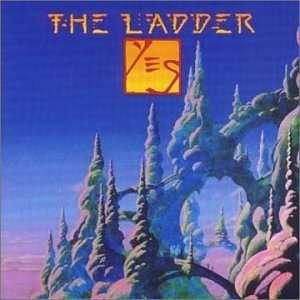
The Ladder is the sixteenth album by progressive rock band Yes and was released in 1999. The follow-up to 1997's tepidly-received Open Your Eyes, The Ladder was seen as a conscious return to the classic Yes sound, while maintaining a contemporary edge. It is the first Yes album to feature Igor Khoroshev as an official member.
Tracks:
1. "Homeworld (The Ladder)" – 9:32
o The song references the working title for Talk, History of the Future.
2. "It Will Be a Good Day (The River)" – 4:54
3. "Lightning Strikes" – 4:35
4. "Can I?" – 1:32
o The song references Anderson's 1971 composition "We Have Heaven" from Fragile
5. "Face to Face" – 5:02
o The song references "Lift Me Up" from Union
6. "If Only You Knew" – 5:43
o The song references the title of Anderson and Khoroshev's shelved 2000 collaboration album, True You, True Me.
7. "To Be Alive (Hep Yadda)" – 5:07
8. "Finally" – 6:02
9. "The Messenger" – 5:13
o A tribute to Bob Marley
10. "New Language" – 9:19
o Based on a jam from the Open Your Eyes album sesions.
11. "Nine Voices (Longwalker)" – 3:21
o The song references "I've Seen All Good People" from The Yes Album.
Magnification 2001
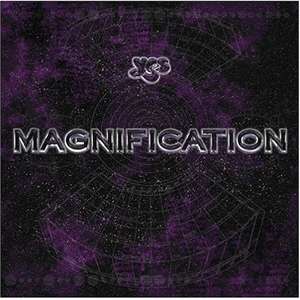
Magnification is the seventeenth album by progressive rock band Yes, released in 2001. The band's first album of the new century, and their second with a full orchestra (the first being Time and a Word from 1970), Magnification has proven to be one of Yes's more acclaimed later efforts.
Following the departures of guitarist Billy Sherwood and keyboardist Igor Khoroshev, and Rick Wakeman's decision not to rejoin the band, remaining members Jon Anderson, Chris Squire, Steve Howe and Alan White decided to fill the keyboard role with an orchestra, and hired film composer Larry Groupé to compose and conduct original orchestrations and musical bridges.
The album was re-released in 2002 as a limited and numbered 2CD set with alternate artwork; the second disc contains three live performances and a CD-ROM track with an interview, video of "Don't Go," and a live video of "The Gates Of Delirium". This album also features the only Yes song in which the main vocals are sung by Chris Squire with Jon Anderson on backing vocals ("Can You Imagine").
Magnification received a warm reception from critics and fans, although not on the level of classic albums such as Fragile or Close to the Edge; the album reached #71 in the UK and #186 in the US.
Tracks:
1. "Magnification" – 7:16
2. "Spirit Of Survival" – 6:02
3. "Don't Go" – 4:27
4. "Give Love Each Day" – 7:44
5. "Can You Imagine" – 2:59
6. "We Agree" – 6:30
7. "Soft as a Dove" – 2:17
8. "Dreamtime" – 10:46
9. "In the Presence Of" – 10:24
"i) Deeper"
"ii) Death of Ego"
"iii) True Beginner"
"iv) Turn Around and Remember"
10. "Time Is Time" – 2:09
11. "Close to the Edge" [Live] - 20:04
12. "Long Distance Runaround" [Live] - 3:44
13. "The Gates of Delirium" [Live] - 22:41
Enjoy Yes :)
















